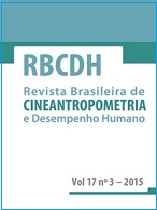Potencia aeróbia e saltos predizem desempenho de corrida intermitente em jovens jogadores de futsal
DOI:
https://doi.org/10.1590/1980-0037.2015v17n3p357Resumen
O futsal é uma modalidade intermitente, na qual se exige esforços de alta intensidade de diferentes demandas, como potência aeróbia e potência muscular. Dessa forma, a busca pelo aprimoramento dessas exigências a partir de relações entre si pode ser ferramenta relevante para o esporte. Buscou-se correlacionar e calcular equações preditivas para diferentes variáveis de aptidão física em protocolos de esforços intermitentes. Dezoito jogadores de futsal (15 ± 1,3 anos, 75,4 ± 20,2 kg, 167 ± 0,8 cm) foram avaliados quanto à capacidade de repetir corridas (a partir do Forward-Backward test), potência aeróbia máxima (PAM, com o Yo-Yo Intermitent Recovery Test) e potência de membros inferiores (salto horizontal triplo, SHT). O teste de Pearson foi utilizado para as correlações e o método stepwise para as regressões lineares. Além de diferentes correlações significantes, considerando o desempenho no SHT e de PAM, foram observados valores de determinação de 44% a 64% na capacidade de repetir corridas. Neste contexto, a PAM e SHT podem predizer o tempo em diferentes séries de esforços repetidos (p?0,02) e potências mínima, média e máxima (p<0,05). Concluiu-se PAM e desempenho no SHT podem determinar e, inclusive, predizer a capacidade de repetir corridas.
Descargas
Publicado
Número
Sección
Licencia

Direitos Autorais para artigos publicados nesta revista são do autor, com direitos de primeira publicação para a revista. Em virtude da aparecerem nesta revista de acesso público, os artigos são de uso gratuito, com atribuições próprias, em aplicações educacionais e não-comerciais, desde que seja dada a atribuição. Esta obra foi licenciada com uma Licença Creative Commons Atribuição 4.0 Internacional - CC BY


